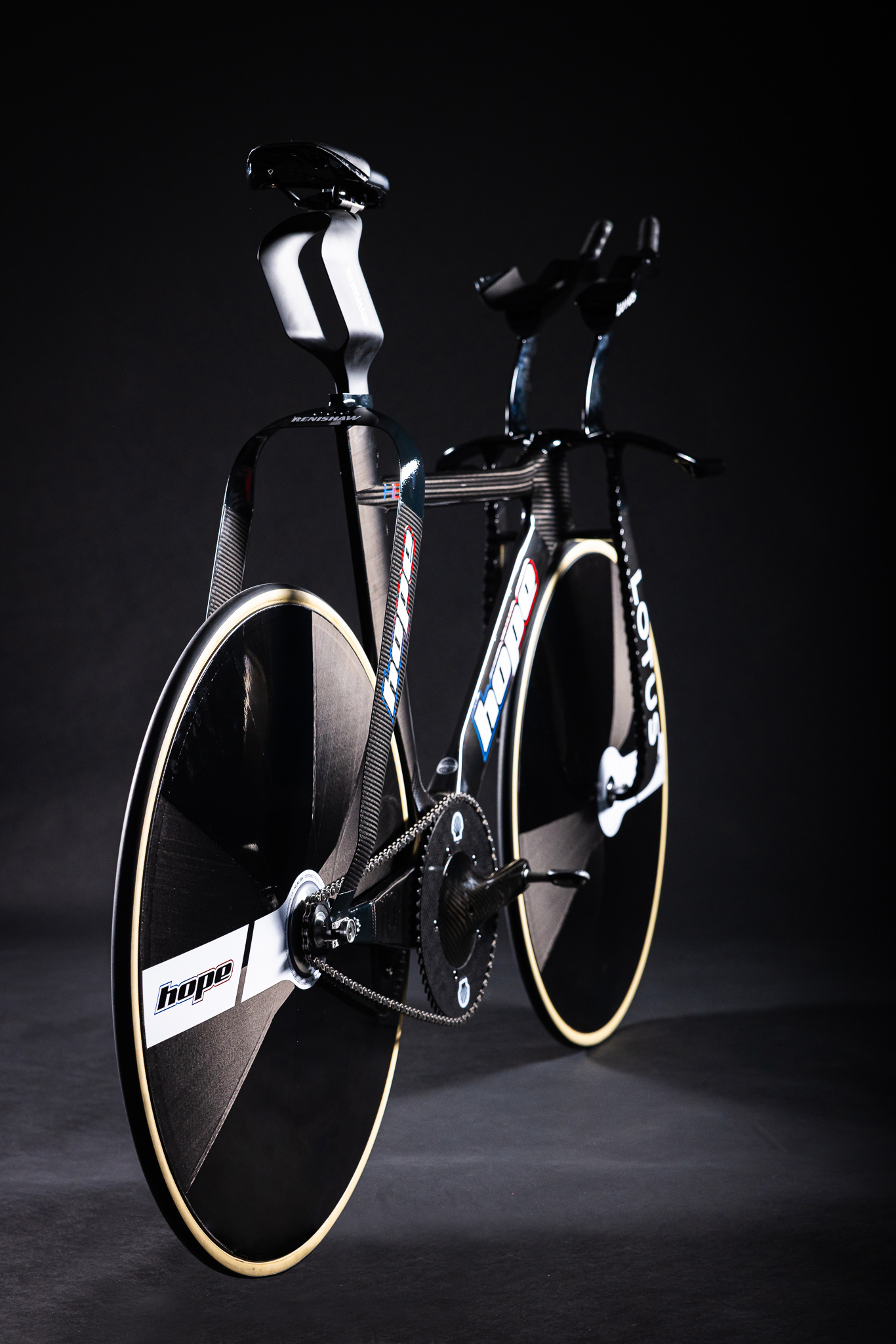
Lots of new bikes land on the scene to some moderate fanfare. Some create a buzz before they are even officially launched, and others simply trickle onto the market totally unnoticed.
The original Hope x Lotus track bike caused a stir unlike any I've ever seen when it was launched in 2019 ahead of the Tokyo Olympics. With the Paris Olympics on the horizon for 2024, and the Glasgow World Championships the last opportunity for teams to use their new equipment to be in line with registration requirements, it means we're getting a glimpse of a new beast.
As with debut albums, the first iteration is a tough act to follow, but the difficult second album is bringing 'wobbly bits' to the table, while seemingly still keeping the tried and tested madness of 'absurdly wide set fork legs'. This also follows the 3D-printed, extremely bonkers-looking Toot Racing track bike that we've covered, to be used by the Argentinian track squad. Is track where it's at for new tech this year?

What's new?
The press material we have received includes no real tech details, but given the secrecy that often surrounds Olympic-level tech, where thousandths of a second separate winners, this is no great surprise. The short version is that the bike is still a collaboration with Hope, Lotus, and Renishaw, an additive manufacturing company (read: 3D printing for Titanium).
In terms of changes from the old bike, we will have to rely on visual clues. Up front, the most obvious change is with the handlebars. The old bar was a normal (in the context of the bike as a whole) looking set of bars with a flat crossbar, whereas here the bars rise up from the top of the headtube like a pair of ram's horns. Lotus Engineering, which had the responsibility to develop the front end further, claims the bars and forks are more integrated and more customisable than before.
Without geometry charts, it's impossible to say, but this may indicate that the front end of the bike is lower, compensated by the rise of the bars. We see this on the road with the Cervelo S5 and in a lesser way with the new Bianchi Oltre.

If your eyes aren't immediately drawn to the front of the bike, they will be to the rear, specifically to the seatpost. Given the Renishaw logo, and the textured surface we're assuming this component is 3D printed from Titanium. This isn't unusual in and of itself, as we've seen near-entire bikes printed from Titanium like the Sturdy Cycles Fiadh, but the gaping hole created by a Y-shaped, rearward leaning set of blades is certainly totally new, though it does definitely put us in mind of the IsoFlow hole seen at the rear of the new Trek Madone. It's assumed it has the same function, that being to create smoother airflow around the rear of the bike. Given it exists above the top tube, between the rider's legs, and also is interrupted by the bars thanks to their V-shaped profile, it's conceivable that a cylinder of clean air could pass through the bike and under the rider totally unimpeded.
Back to the front again, and area of the bike under the Remit of Lotus Engineering. The fork legs feature the same crenulations that we've seen on the front of the seat tube of Filippo Gannas hour record bike, a bike which also featured 3D printing, insofar as the frame was printed entirely from aluminium. These wavy trailing edges, according to Lotus, are inspired by fighter jet design. It's expected that this is to help the air detach, and is a similar pattern, if at a smaller scale, to what we've seen on Princeton Carbonworks wheels and wheels like the Zipp 353 NSW. The carbon used in the fork legs, we are told, utilises the same manufacturing process as that used in the creation of the Lotis Evija Hypercar.
Finally, from what I can decipher from the gloomy pictures, the seatstays are now straight, rather than slightly curved, but interestingly they lack the wavy trailing edges that the fork blades have. The titanium parts that it seems are still being used to join the carbon pieces together are also now black rather than grey. this could be cosmetic, but it wouldn't be a great surprise to learn down the line that they are coated in some kind of speed coating that's more aerodynamic, or perhaps photodynamic?
In terms of concrete improvements, we have no facts to go off. Despite this Lotus Engineering claims to have created "significant aerodynamic gains" over the previous model.

What hasn't changed?
The whole stance of the thing itself seems common between the two models. The wide fork legs, the seat stays that join above the gently sloping top tube. The general silhouette, basically, is unchanged, but with the details reiterated and refined for 2024.
The use of 3D-printed titanium is still a common theme, though its utilisation seems to be used more in some areas and less in others. The crazy seat post, not seen in every photo - suggesting it's an option, not a prerequisite - is titanium where before it was carbon, while the front end utilised more carbon in places where Ti was previously used.
As well as the general shape, the dual functionality as both a mass start bike (with drop bars) or an individual/pursuit bike (with TT bars) is still present with just a swap out of the front end. We still expect to see riders having individually tailored bar extensions to maximise their aero advantage.
Details are, as I mentioned, thin on the ground, but as soon as we know more we will update this page accordingly, so be sure to check back in.








